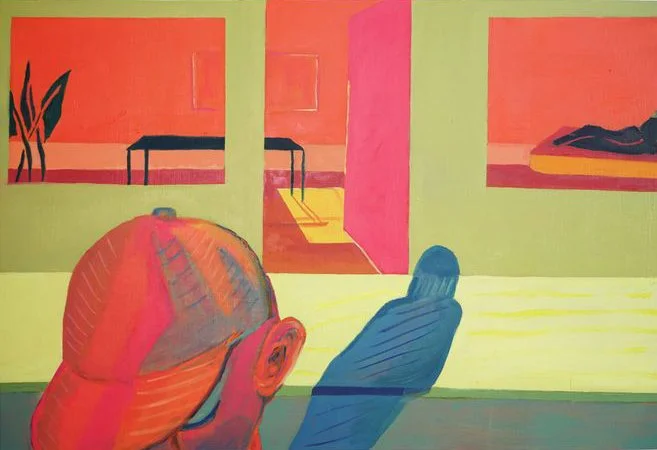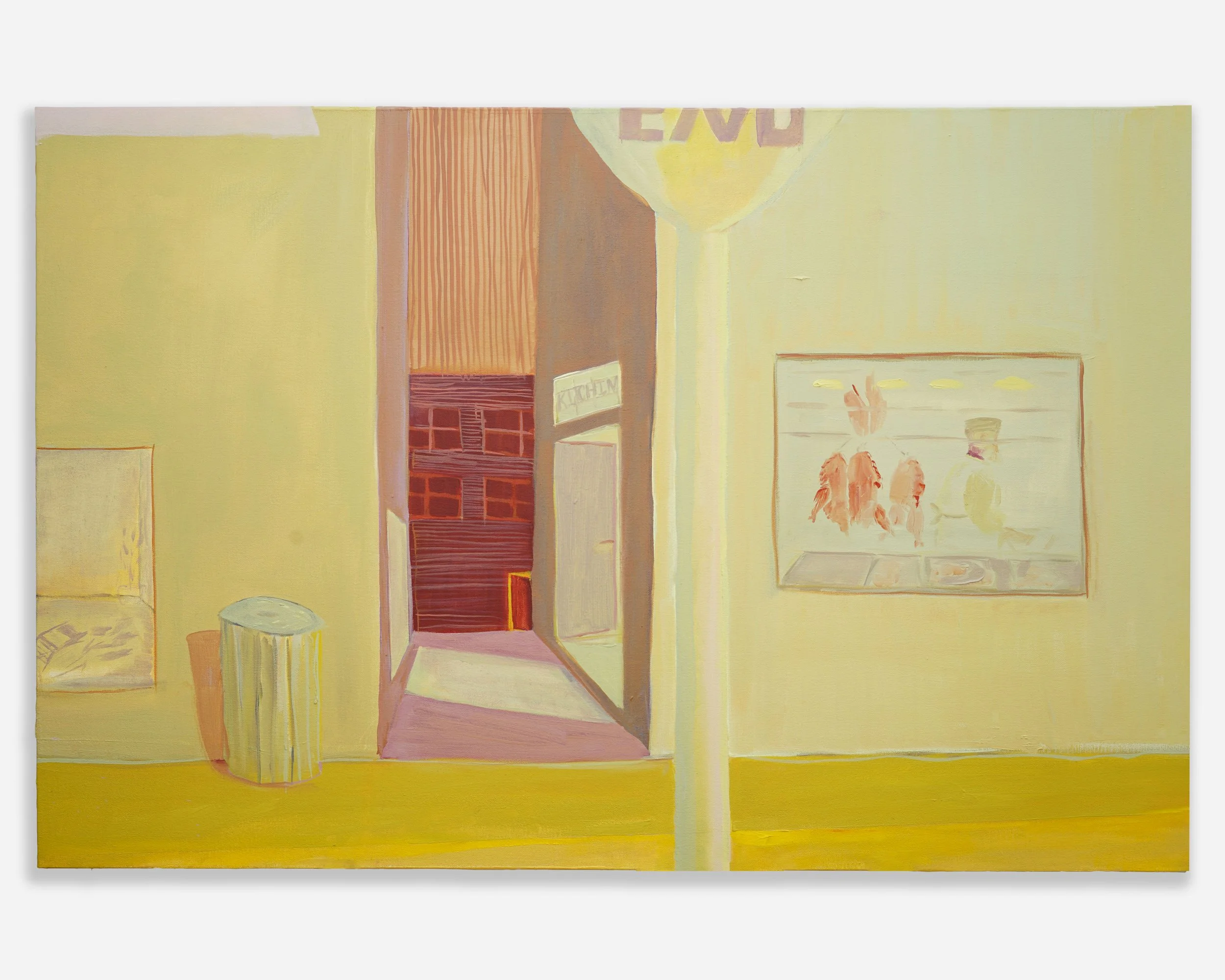Interview with Paul-Sebastian Japaz
Paul-Sebastian Japaz
Paul-Sebastian Japaz is a painter who currently resides in New York. In 2017, he graduated with a BFA in Fine Art from the Fashion Institute of Technology. Paul uses space to explore the idea that it can influence behaviours in people. Positive Space is a resource, and in many cases a privilege afforded to those in power. The work considers Queer identity and places it in the context of everyday life through the power of space and environment to define a place of our own.
Paul is interviewed by Angeliki Kim-Jonsson, who Is the founder of DYNAMISK Independent Curating and Art Advisory. Angeliki works as an Independent Curator and Art Advisor on a multitude of curatorial and art advisory projects, studio visits, workshops, art talks and tours.
INTERVIEW WITH PAUL-SEBASTIAN JAPAZ AND ANGELIKI KIM-JONSSON
Angeliki: Tell me more about you!
Paul-Sebastian: I’m a painter based in NYC, I’m Queer and Latin and hugely proud to be both. I studied art at FIT and my work is about space used to explore the idea that it can influence behaviors in people. Positive Space is a resource, and in many cases a privilege afforded to those in power. The work considers Queer identity and places it in the context of everyday life through the power of space and environment to define a place of our own.
Angeliki: How and where do you find inspiration?
Paul-Sebastian Japaz
Outside Looking In, 2021
Oil on canvas, 24 x 36 in.
Paul-Sebastian: Finding inspiration is the easy bit, I guess I'm just lucky that way. I find it through my surroundings and my community for the most part. Seeing my peers be successful is a huge inspiration for me. I love knowing I can approach someone whose work fascinates me and have a casual conversation about what they do. That understanding of the desire of creation and a humanistic approach provides reference to my work. But also, helps me make most use of my surroundings and be more receptive to whatever elements I want to use in my work.
Angeliki: How do you work? Systematically? With music? Whilst dancing? Is your studio messy? Or in order? Paint me the scene!
Paul-Sebastian: I work best in very clean and orderly workspaces. I lose focus very quickly and I learned the best way to hold onto that attention is by eliminating all distractions. I keep my phone on the other side of the room to prevent me from going on Instagram, use noise canceling headphones playing some trashy horror podcast or my studio’s playlist which is mostly disco because it’s upbeat twelve-minute songs with not a lot of variation all to keep me catatonic through the day. I keep a color diary of whatever painting I’m working on, which gives me a more simplified view of the work’s palette. Also, it keeps track of how I arrived at a certain color and puts me back into the mindset I was in while working, which I really need. What’s the point of getting to a great place in any work if I can’t do it again?
Angeliki: If you could swap studio for a month with an artist who would you swap with?
Paul-Sebastian: Studios are something I think about a lot! At the moment my space is very modest at most. That being said, I imagine what I can do in a different space. I think a lot about Cy Twombly’s Rome studio or even Judd’s Spring Street villa. My goal for a studio space would be one where you could make work, but also host people who are interested in seeing your work. So anywhere that has a lot of space in a metropolitan area would work great because I’m also not driving anywhere.
Angeliki: Did Covid have an impact on your work?
Paul-Sebastian: Covid impacted my whole career. I had a full time position at a fancy art job until covid hit and I, like many other creatives, had to juggle between their studio selves and their 9-5 selves (it was more like 9-7 or 8 but who's counting?). In fact, even though I worked for one of the biggest players in the art world, nobody there really knew I was a painter. Up until covid I never felt comfortable or confident taking the jump on my art career. During the early months of covid when we couldn’t leave our homes and I didn’t have to be in an office I spent that time building the foundation of my career. When my job downsized and ultimately let me go, I knew I didn’t want to go backward and find another job where I had to juggle two lives. I had to figure out a way to make the art career sustainable, especially the “career” part. I was making a lot of work and just letting it sit in the studio, expecting someone to come to me to make something out of it until I realized I needed to take control. It took me that long term focused amount of time that covid gave me to make something of my career. I realize how lucky I am to have made that happen.
Angeliki: Tell me more about the subject matter, do the symbols have specific meanings? What about the composition?
Paul-Sebastian: Much of my work involves some kind of storytelling. As a queer person I want those stories to be relevant and relatable to other queer people. However, the more nuanced aspects of my work show through colour, composition and tone. For starters, much of my work focuses heavily on “space” and it’s important for me to communicate the idea of space instead of a space that would actually exist.
I also want to maintain the viewer feeling like they’re on the outside looking in (even if it’s an interior painting). That disconnect is very important to my work, at the very least it helps in telling the story. In terms of subject matter I want any and all feelings, emotions and preconceptions to come along with every object I’m using. Who is the kind of person that would have this kind of chair? What does it mean when you have a lit cigarette in an empty room? Why are there two people entering a room late at night, and on this table are all these plates of half eaten food? Those seeds of narrative drive my work and help it unfold into this amalgamation of queer based narratives.
Angeliki: If you would have to describe your practice in three words what would that be?
Paul-Sebastian: “Queer paints space” Is that cheesy?
“Queer space stories”......
It exists somewhere in there...
Angeliki: How have your practice developed/ changed over the years? Do you think it’s important for artists to experiment or do you think an artist should stay with one style?
Paul-Sebastian: I wanted to be an abstract sculptor, and a lot of my work then relied on the narrative of materials. So think: concrete wrapped in rice paper totems, lots of wall reliefs, a lot of physicality. I don’t really recognize that person anymore, although I never decided one day to change. I also didn’t want to nurture that theory process either. Change will happen if it happens, follow the green lights in your path and if you’re doing something in your practice that you’re passionate about you’ll know that it’s worth being resolute.
But also, yes, you should be experimenting.
Paul-Sebastian Japaz
Alley Kitchen, 2021
Oil on canvas, 36 x 24 in.
Angeliki: If you could own a work of art from any artist and any art movement which one would it be and why?
Paul-Sebastian: Hmmm...it would probably be that Hockney that went up for auction a few years back. (Pool with two figures) watching that unfold was....surreal. I remember seeing the piece in person for the first time at his retrospective in 2017. The show was a madhouse but I was lucky enough to have roughly 10 seconds with the work without the completion of the hundred other people trying to see the work, and then a few years later the 90.M price tag happened. I would rather own Lincoln Center though, and live in it like how the president lived in the lobby of the Empire State Building in Vonnegut’s Slapstick ...but it’s ok, because we would all be invited. In fact I’ll even install this newly acquired Hockney in Lincoln Center.
Angeliki: What has been an art exhibition or project that you’ve enjoyed the most until date?
Paul-Sebastian: Theres been a lot of great shows recently, but the one that really sticks with me is from 2016 that rooftop Cornelia Parker installation. With the “American-styled” prop house that, if you walked around it you could see it was held up by poles and sandbags. It was made to reference the Barn-house in Hitchhock’s “Psycho“, as well as the insecurities of Americana that Hopper explored in his work. Installed with the backdrop of NYC, the Hustle and grind city which embodies those insecurities though capitalism.
Seeing art in NYC is always a little masochistic. The great big shows with the great big budgets also come with the great big crowds. But hey, it shows that the demand for art is so important
Angeliki: Do you think that the city you live in impacts you and your art?
Paul-Sebastian Japaz
Stepping out, 2021
Oil on canvas, 24 x 18 in.
Paul-Sebastian: Absolutely....and my art career. I’m very fortunate to live in NYC and do my best to squeeze myself into the community here. But also, I spend all day walking around. All day meeting people, and all day working in the studio. I also don’t drive. So NYC is probably the only place I can do what I’m doing, how I’m doing it, successfully.
Angeliki: What skills does a contemporary artist need today? If you could go back and give your young self an advice what would that be?
Paul-Sebastian: Know how to run a business. Keep your own best interest top of mind. Be your own biggest fan first.
Angeliki: We are in a time where the self is extremely important and celebrated. What defines you as an artist?
Paul-Sebastian: I’m Queer, Latin person who grew up with not very much. My work does deal with a lot of guarded love, lots of insecurities within my community and a desire to build something that benefits people around me to help build ourselves. I think my work Is accessible, but it’s not familiar unless you understand this community, and that’s okay.
I realize the stories of people who are different and of color in America are received by very defensive ears. I can’t change that, but I’m going to continue to contribute to make sure that the information and art about us is rich.
Angeliki: Tell me more about the selection of titles, how does an Artist choose a title and in some cases not? '
Paul-Sebastian: Well, I think a title is another tool. It’s another opportunity to do another thing with your work. However, I also think a title can in some instances over step and be a little too on the nose. I love pulling a Untitled (“Title TK”) because it’s a way of separating the title from the work and having the viewer understand these are somewhat separate. Also, sometimes I will intentionally not capitalize the start of the title or not end with a period to suggest that this exists within information you’re not getting.




